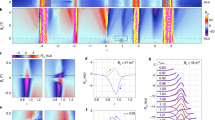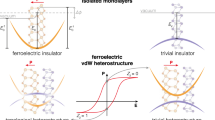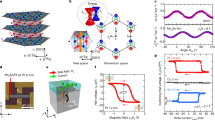Abstract
Magnetism typically arises from the joint effect of Fermi statistics and repulsive Coulomb interactions, which favours ground states with non-zero electron spin. As a result, controlling spin magnetism with electric fields—a longstanding technological goal in spintronics and multiferroics1,2—can be achieved only indirectly. Here we experimentally demonstrate direct electric-field control of magnetic states in an orbital Chern insulator3,4,5,6, a magnetic system in which non-trivial band topology favours long-range order of orbital angular momentum but the spins are thought to remain disordered7,8,9,10,11,12,13,14. We use van der Waals heterostructures consisting of a graphene monolayer rotationally faulted with respect to a Bernal-stacked bilayer to realize narrow and topologically non-trivial valley-projected moiré minibands15,16,17. At fillings of one and three electrons per moiré unit cell within these bands, we observe quantized anomalous Hall effects18 with transverse resistance approximately equal to h/2e2 (where h is Planck’s constant and e is the charge on the electron), which is indicative of spontaneous polarization of the system into a single-valley-projected band with a Chern number equal to two. At a filling of three electrons per moiré unit cell, we find that the sign of the quantum anomalous Hall effect can be reversed via field-effect control of the chemical potential; moreover, this transition is hysteretic, which we use to demonstrate non-volatile electric-field-induced reversal of the magnetic state. A theoretical analysis19 indicates that the effect arises from the topological edge states, which drive a change in sign of the magnetization and thus a reversal in the favoured magnetic state. Voltage control of magnetic states can be used to electrically pattern non-volatile magnetic-domain structures hosting chiral edge states, with applications ranging from reconfigurable microwave circuit elements to ultralow-power magnetic memories.
This is a preview of subscription content, access via your institution
Access options
Access Nature and 54 other Nature Portfolio journals
Get Nature+, our best-value online-access subscription
$29.99 / 30 days
cancel any time
Subscribe to this journal
Receive 51 print issues and online access
$199.00 per year
only $3.90 per issue
Buy this article
- Purchase on Springer Link
- Instant access to full article PDF
Prices may be subject to local taxes which are calculated during checkout




Similar content being viewed by others
Data availability
Source data are available for this paper. All other data that support the plots within this paper and other findings of this study are available from the corresponding author upon reasonable request. Source data are provided with this paper.
References
Matsukura, F., Tokura, Y. & Ohno, H. Control of magnetism by electric fields. Nat. Nanotechnol. 10, 209–220 (2015).
Jiang, S., Shan, J. & Mak, K. F. Electric-field switching of two-dimensional van der Waals magnets. Nat. Mater. 17, 406–410 (2018).
Sharpe, A. L. et al. Emergent ferromagnetism near three-quarters filling in twisted bilayer graphene. Science 365, 605–608 (2019).
Serlin, M. et al. Intrinsic quantized anomalous Hall effect in a moiré heterostructure. Science 367, 900–903 (2020).
Chen, G. et al. Tunable correlated Chern insulator and ferromagnetism in a moiré superlattice. Nature 579, 56–61 (2020); correction 581, E3 (2020).
Lu, X. et al. Superconductors, orbital magnets and correlated states in magic-angle bilayer graphene. Nature 574, 653–657 (2019).
Xie, M. & MacDonald, A. Nature of the correlated insulator states in twisted bilayer graphene. Phys. Rev. Lett. 124, 097601 (2020).
Bultinck, N., Chatterjee, S. & Zaletel, M. P. Mechanism for anomalous Hall ferromagnetism in twisted bilayer graphene. Phys. Rev. Lett. 124, 166601 (2020).
Zhang, Y.-H., Mao, D. & Senthil, T. Twisted bilayer graphene aligned with hexagonal boron nitride: anomalous Hall effect and a lattice model. Phys. Rev. Res. 1, 033126 (2019).
Liu, J. & Dai, X. Theories for the correlated insulating states and quantum anomalous Hall phenomena in twisted bilayer graphene. Preprint at https://arxiv.org/abs/1911.03760 (2020).
Wu, F. & Das Sarma, S. Collective excitations of quantum anomalous Hall ferromagnets in twisted bilayer graphene. Phys. Rev. Lett. 124, 046403 (2020).
Chatterjee, S., Bultinck, N. & Zaletel, M. P. Symmetry breaking and skyrmionic transport in twisted bilayer graphene. Phys. Rev. B 101, 165141 (2020).
Repellin, C., Dong, Z., Zhang, Y.-H. & Senthil, T. Ferromagnetism in narrow bands of moiré superlattices. Phys. Rev. Lett. 124, 187601 (2020).
Alavirad, Y. & Sau, J. D. Ferromagnetism and its stability from the one-magnon spectrum in twisted bilayer graphene. Preprint at https://arxiv.org/abs/1907.13633 (2019).
Ma, Z. et al. Topological flat bands in twisted trilayer graphene. Preprint at https://arxiv.org/abs/1905.00622 (2019).
Park, Y., Chittari, B. L. & Jung, J. Gate-tunable topological flat bands in twisted monolayer-bilayer graphene. Phys. Rev. B 102, 035411 (2020).
Rademaker, L., Protopopov, I. V. & Abanin, D. A. Topological flat bands and correlated states in twisted monolayer-bilayer graphene. Phys. Rev. Res. 2, 033150 (2020).
Chang, C.-Z. et al. Experimental observation of the quantum anomalous Hall effect in a magnetic topological insulator. Science 340, 167–170 (2013).
Zhu, J., Su, J.-J. & MacDonald, A. H. The curious magnetic properties of orbital Chern insulators. Preprint at https://arxiv.org/abs/2001.05084 (2020).
Haldane, F. D. M. Model for a quantum Hall effect without Landau levels: condensed-matter realization of the “parity anomaly”. Phys. Rev. Lett. 61, 2015–2018 (1988).
Song, J. C. W., Samutpraphoot, P. & Levitov, L. S. Topological Bloch bands in graphene superlattices. Proc. Natl Acad. Sci. USA 112, 10879–10883 (2015).
Zhang, Y.-H., Mao, D., Cao, Y., Jarillo-Herrero, P. & Senthil, T. Nearly flat Chern bands in moiré superlattices. Phys. Rev. B 99, 075127 (2019).
Liu, J., Ma, Z., Gao, J. & Dai, X. Quantum valley Hall effect, orbital magnetism, and anomalous Hall effect in twisted multilayer graphene systems. Phys. Rev. X 9, 031021 (2019).
Bistritzer, R. & MacDonald, A. H. Moiré bands in twisted double-layer graphene. Proc. Natl Acad. Sci. USA 108, 12233–12237 (2011).
Cao, Y. et al. Correlated insulator behaviour at half-filling in magic-angle graphene superlattices. Nature 556, 80–84 (2018).
Chen, G. et al. Evidence of a gate-tunable Mott insulator in a trilayer graphene moiré superlattice. Nat. Phys. 15, 237–241 (2019).
Shen, C. et al. Correlated states in twisted double bilayer graphene. Nat. Phys. 16, 520–525 (2020).
Liu, X. et al. Tunable spin-polarized correlated states in twisted double bilayer graphene. Nature 583, 221–225 (2020).
Cao, Y. et al. Tunable correlated states and spin-polarized phases in twisted bilayer–bilayer graphene. Nature 583, 215–220 (2020); correction 583, E27 (2020).
Burg, G. W. et al. Correlated insulating states in twisted double bilayer graphene. Phys. Rev. Lett. 123, 197702 (2019).
He, M. et al. Symmetry breaking in twisted double bilayer graphene. Nat. Phys. https://doi.org/10.1038/s41567-020-1030-6 (2020).
Streda, P. Quantised Hall effect in a two-dimensional periodic potential. J. Phys. C 15, L1299 (1982).
Tschirhart, C. L. et al. Imaging orbital ferromagnetism in a moiré Chern insulator. Preprint at https://arxiv.org/abs/2006.08053 (2020).
Chiba, D. et al. Anomalous Hall effect in field-effect structures of (Ga,Mn)As. Phys. Rev. Lett. 104, 106601 (2010).
Zhang, S. et al. Experimental observation of the gate-controlled reversal of the anomalous Hall effect in the intrinsic magnetic topological insulator MnBi2Te4 device. Nano Lett. 20, 709–714 (2020).
Beekman, M., Heideman, C. L. & Johnson, D. C. Ferecrystals: non-epitaxial layered intergrowths. Semicond. Sci. Technol. 29, 064012 (2014).
Viola, G. & DiVincenzo, D. P. Hall effect gyrators and circulators. Phys. Rev. X 4, 021019 (2014).
Lian, B., Sun, X.-Q., Vaezi, A., Qi, X.-L. & Zhang, S.-C. Topological quantum computation based on chiral Majorana fermions. Proc. Natl Acad. Sci. USA 115, 10938–10942 (2018).
Acknowledgements
We acknowledge discussions with J. Checkelsky, S. Chen, C. Dean, M. Yankowitz, D. Reilly, I. Sodemann and M. Zaletel. Work at UCSB was primarily supported by the ARO under MURI W911NF-16-1-0361. Measurements of twisted bilayer graphene (Extended Data Fig. 8) and measurements at elevated temperatures (Extended Data Fig. 3) were supported by a SEED grant and made use of shared facilities of the UCSB MRSEC (NSF DMR 1720256), a member of the Materials Research Facilities Network (www.mrfn.org). A.F.Y. acknowledges the support of the David and Lucille Packard Foundation under award 2016-65145. A.H.M. and J.Z. were supported by the National Science Foundation through the Center for Dynamics and Control of Materials, an NSF MRSEC under Cooperative Agreement number DMR-1720595, and by the Welch Foundation under grant TBF1473. C.L.T. acknowledges support from the Hertz Foundation and from the National Science Foundation Graduate Research Fellowship Program under grant 1650114. K.W. and T.T. acknowledge support from the Elemental Strategy Initiative conducted by the MEXT, Japan, Grant Number JPMXP0112101001, JSPS KAKENHI grant numbers JP20H00354 and the CREST(JPMJCR15F3), JST.
Author information
Authors and Affiliations
Contributions
H.P., M.A.K. and Y.Z. fabricated the devices. H.P., F.Y., C.L.T. and M.S. performed the measurements, advised by A.F.Y. J.Z. and A.H.M. performed the band structure calculations. K.W. and T.T. grew the hexagonal boron nitride crystals. H.P., A.H.M. and A.F.Y. wrote the manuscript with input from all other authors.
Corresponding author
Ethics declarations
Competing interests
The authors declare no competing interests.
Additional information
Peer review information Nature thanks the anonymous reviewers for their contribution to the peer review of this work. Peer reviewer reports are available.
Publisher’s note Springer Nature remains neutral with regard to jurisdictional claims in published maps and institutional affiliations.
Extended data figures and tables
Extended Data Fig. 1 tMBG devices.
a, Optical image of a typical graphene flake containing both MLG and BLG domains. b, The same image as in a but in greyscale and with enhanced contrast to clearly show the graphene flake. Dashed lines show the lines along which the flake was cut using atomic force microscopy. c–f, Optical images of completed tMBG devices D1 (c), D2 (d), D3 (e) and D4 (f). All scale bars, 10 μm.
Extended Data Fig. 2 Longitudinal resistance of tMBG devices with different twist angles.
a–d, Longitudinal resistance Rxx of devices D1 with θ ≈ 1.25(1)° (a), D2 with θ ≈ 1.25(1)° (b), D3 with θ = 1.385(5)° (c) and D4 with θ ≈ 0.90(1)° (d). The numbers in parentheses indicate the uncertainty in the final digit. All measurements are performed at zero magnetic field and T ≈ 20 mK.
Extended Data Fig. 3 Temperature dependence of the correlated states in device D1.
a, Temperature-dependent resistance measured at D = 0.43 V nm−1 in device D1. b, c, Temperature-dependent resistance at selected carrier densities, marked by the arrows in a, for n < 0 (b) and n > 0 (c).
Extended Data Fig. 4 Development of Hall resistance at different n and D in device D1.
a, Longitudinal resistance Rxx of the correlated region at B = 0 T. b–e, Hall resistance Ryx measured at n and D marked by the dots in a. The colour of the dots in a corresponds to the colour of curves in b–e. Panels b and c show curves taken at small negative and positive dopings of ν = 1. Panels d and e show curves taken at small negative and positive dopings of ν = 2. f, Zoom-in of Rxx around ν = 1. g–i, Ryx measured along the line cuts I (g), II (h) and III (i). Ryx in the plots are shifted by an offset.
Extended Data Fig. 5 Development of Hall resistance in device D3.
a, Longitudinal resistance Rxx of the correlated region at B = 0 T. b, Hall resistance Ryx of the same region as in a. c, Temperature dependence of Ryx at ν = 1. The anomalous Hall effect disappears at 4.2 K. d, Rxx of the correlated region measured at B = 2 T. e–i, Ryx along the line cuts I (e), II (f), III (g), IV (h) and V (i).
Extended Data Fig. 6 Temperature dependence of the hysteresis at ν = 1 and ν = 3 in device D1.
a, b, Temperature dependence of the Hall resistance Ryx measured at ν = 1 (a) and ν = 3 (b). Insets show the temperature dependence of the height of the hysteresis loop height, as defined in Fig. 3a.
Extended Data Fig. 7 n and B dependence of the measured anomalous Hall effect, plotted at selected temperatures for D = 0.4 V nm−1 in device D1.
Temperatures are labelled on the individual panels.
Extended Data Fig. 8 Magnetization reversal in tBLG.
a, Anomalous Hall resistance ΔRyx associated with tBLG ferromagnetism, extracted by subtracting Ryx(B) as B is increased from Ryx(B) as B is decreased. The tBLG device is the same as in ref. 4. The colour scale is fixed to the von Klitzing constant in the top of the plot to show the range of filling factors for which a robust quantum anomalous Hall effect is observed. The colour scale axis is dramatically reduced in the bottom plot to illustrate weak features in ΔRyx(ν). For ν < 3, the coercive field of the ferromagnetic order increases dramatically, peaking at ν = 2.82 electrons per moiré unit cell. For ν < 2.82, ΔRyx switches sign, indicating that the valley polarization of the ground state of the system at finite magnetic field has switched. b, A robust C = 1 quantum anomalous Hall effect at ν = 3.1. c, Ferromagnetic hysteresis plots on opposite sides of the divergence of the coercive field close to ν = 2.82 (with offset). Note the change in the relative sign of ΔRyx.
Extended Data Fig. 9 Repeatability of magnetization switching with B and n measured in device D1.
a, Repeated magnetic-field hysteresis loops. b, Repeated doping hysteresis loops. Both panels taken under conditions analogous to those in Fig. 4b, described in the main text.
Supplementary information
Supplementary Information
This file contains Supplementary Text and Data Sections 1–3, including Supplementary Figures 1–4 and Supplementary References.
Rights and permissions
About this article
Cite this article
Polshyn, H., Zhu, J., Kumar, M.A. et al. Electrical switching of magnetic order in an orbital Chern insulator. Nature 588, 66–70 (2020). https://doi.org/10.1038/s41586-020-2963-8
Received:
Accepted:
Published:
Issue Date:
DOI: https://doi.org/10.1038/s41586-020-2963-8
This article is cited by
-
Angle-resolved transport non-reciprocity and spontaneous symmetry breaking in twisted trilayer graphene
Nature Materials (2024)
-
Ferroelectric and spontaneous quantum Hall states in intrinsic rhombohedral trilayer graphene
Nature Physics (2024)
-
Correlated insulator and Chern insulators in pentalayer rhombohedral-stacked graphene
Nature Nanotechnology (2024)
-
Manipulation of chiral interface states in a moiré quantum anomalous Hall insulator
Nature Physics (2024)
-
Vestigial singlet pairing in a fluctuating magnetic triplet superconductor and its implications for graphene superlattices
Nature Communications (2024)
Comments
By submitting a comment you agree to abide by our Terms and Community Guidelines. If you find something abusive or that does not comply with our terms or guidelines please flag it as inappropriate.



